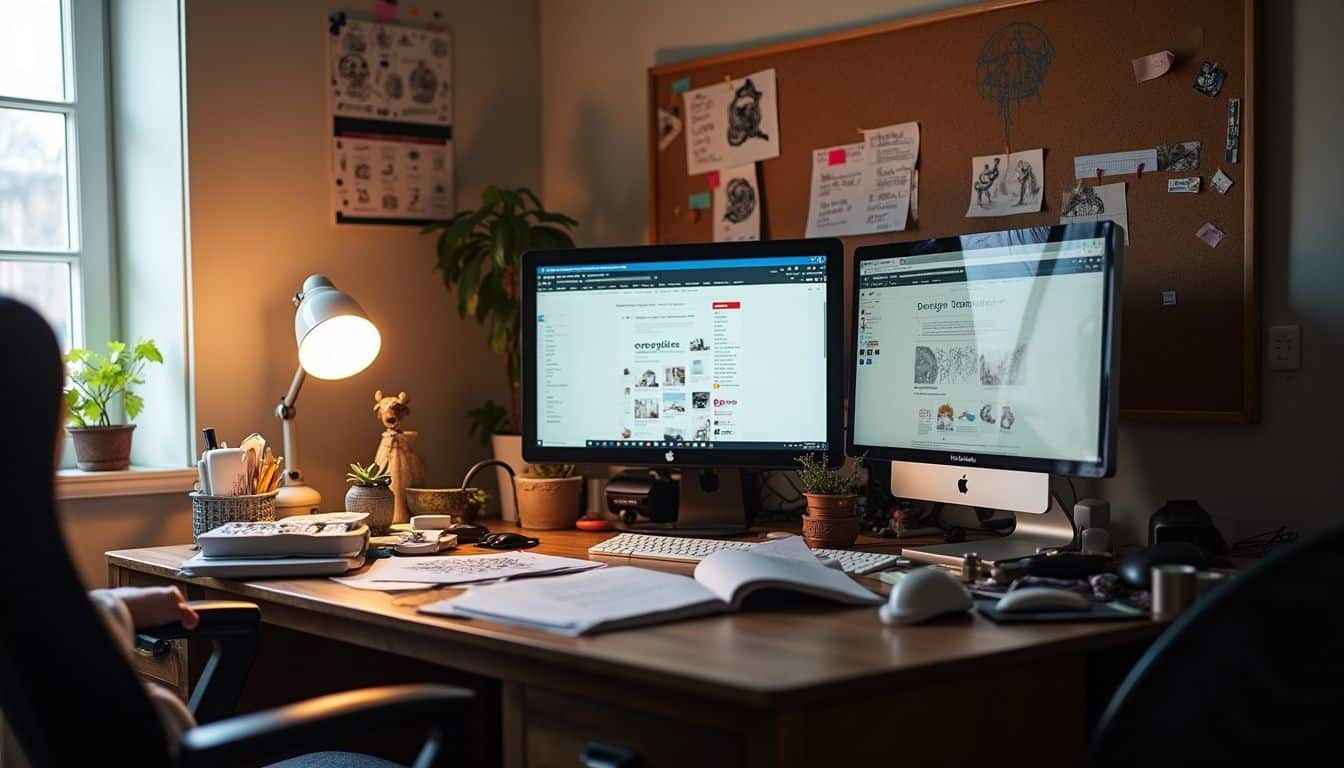Ever find yourself staring at your screen, wondering how to make money as a graphic designer without feeling like you’re just spinning your wheels?
You’re definitely not alone. It’s a question every creative asks.
The good news is that many designers build a successful career, some even hitting six figures in their first year, by creating a strong client base and a memorable brand. I’m going to walk you through more than 20 proven ways to do just that, from selling your own digital products to landing cool gigs with freelance services on Upwork.
So, grab your favorite drink, and let’s get that income rolling together. I’ll show you everything you need to know.
Key Takeaways
Build a powerful portfolio with your top 10-12 projects on sites like Behance for case studies and Dribbble for design snapshots. Keeping it fresh helps you catch the eye of art directors and hiring managers.
Focus on niche services like podcast covers, animated social media graphics, or logos. With the demand for motion graphics expected to grow, specializing in this area can make you a go-to expert.
Sell digital products like templates, fonts, and icons on marketplaces like Gumroad, Creative Market, and Etsy. These platforms give you access to millions of buyers looking for creative assets.
Earn passive income through print-on-demand stores on Printful or Printify. The market for custom apparel and accessories is huge, and you never have to touch any inventory.
Teach your design skills through online courses on platforms like Skillshare or Teachable, or start a YouTube tutorial channel. Once monetized, design channels can earn a steady income from ad revenue and sponsorships.
Table of Contents
Building a Strong Foundation

Getting your basics right is the most important first step. You don’t have to do it alone, though.
You can use platforms like Behance or Dribbble to showcase your work and start building a name for yourself. Mastering tools like Adobe Photoshop, Illustrator, or Figma is also key to creating professional-level work.
How do I develop a professional graphic design portfolio?

A killer graphic design portfolio is your golden ticket in this business. Clients want to see proof of your skill, style, and personality, and they want it fast.
- Show your best 12 works only. Quality over quantity always wins. Don’t include every doodle you’ve ever made.
- Choose pieces that match your target audience or niche. If you want to design for tech startups, your portfolio should be filled with sleek branding and app mockups.
- Master the classics like Adobe Photoshop, Illustrator, and InDesign. These are the industry-standard tools found in the Creative Cloud suite.
- Build a personal website with a custom domain on a platform like Webflow or Squarespace. It makes you look polished and gives you full control over your brand.
- Use Behance to present detailed case studies and Dribbble for quick, eye-catching snapshots of your work. These sites get tons of traffic from art directors.
- Add client testimonials directly next to the projects. If you’re just starting, quotes from professors or former bosses work great to build initial trust.
- Keep your portfolio updated. Trends move fast, so what looked fresh last year might seem dated now. A 2022 study from Adobe showed that retro-futurism was a major trend, but by 2025, things have shifted towards AI-integration and maximalism.
- Show your versatility by mixing formats. Display a branding guide next to a social media campaign or a set of custom icons.
- Install Google Analytics on your website. It’s a free tool that shows you which portfolio pieces get the most clicks, helping you understand what potential clients are looking for.
- Tell a brief story for each project. A simple line like, “Developed a complete e-commerce branding package using Figma for a Shopify store,” adds valuable context.
- Offer a freebie, like a downloadable resume template, to grow your email list. This can quickly turn visitors into potential clients.
- Showcase personal projects, like fonts or icons you’ve created. You can sell these later on an online shop like Creative Market or Etsy.
I found that my project inquiries doubled once I curated my portfolio to only my absolute best work. The right pieces speak for themselves and save everyone time.
How can I create a personal brand as a graphic designer?

Once your graphic design portfolio is polished, it’s time to build your personal brand. A strong brand helps you attract the right clients and confidently set your prices.
It took me a few tries before I settled on my business name and registered it as an LLC, but that step gave my work instant credibility.
https://www.youtube.com/watch?v=o8XE5WiqS_s
Your logo, color palette, and typography should all resonate with your ideal client. Keep these brand elements consistent across every platform, whether it’s Instagram, TikTok, Behance, or even your Twitch stream.
“Your personal brand is what people say about you when you are not in the room.” – Jeff Bezos, Founder of Amazon
Creating content is a powerful way to build your brand. Writing blog posts on design trends or sharing short video tutorials can quickly establish you as an expert. If you can write a guest post for a major design blog like AIGA’s Eye on Design, the traffic and authority boost can be huge.
And don’t forget about in-person networking. Always carry business cards to events and workshops. You never know when you’ll meet your next big client at a local design meetup.
Building a brand takes time, so be patient. Consistent posting and smart networking will pay off.
Where should I showcase my work online, like Behance or Dribbble?

Choosing the right platform to showcase your graphic design work is key to getting noticed.
Behance is perfect for creating in-depth case studies that walk clients through your entire creative process. Dribbble, on the other hand, is great for sharing quick “shots” of your work, like a new logo or UI element, and getting feedback from other professionals.
I set up profiles on both and started getting client leads within a few weeks.
You should also use freelancing platforms like Upwork, Fiverr, or 99designs. These sites let you embed portfolio pieces directly into your profile, so clients can see your skills right away.
Don’t sleep on social media either. Posting your work on Instagram or Pinterest can expose you to a much wider audience beyond the design community. More eyes mean more opportunities.
Ultimately, a personal website with your own custom domain gives you total control and makes you look more professional to bigger brands.
Also, setting up a free Google Business Profile allows you to display reviews and portfolio images, which is fantastic for landing local clients. Just be sure to update all your platforms regularly, as active portfolios tend to rank higher in search results.
Freelancing Opportunities

Freelancing is one of the most direct ways to start earning. Platforms like Upwork and Fiverr have made it easier than ever to connect with clients who need everything from logo designs to complex photo editing using tools like Photoshop.
What are the best platforms for freelance graphic designers?

Finding the right freelancing platform can make all the difference. Each site has its own system, fee structure, and type of client.
- Upwork: As the world’s largest freelancing marketplace, Upwork has a constant stream of graphic design jobs. You can find everything from quick hourly tasks to long-term contracts. The median hourly rate for designers on Upwork is around $25.
- Fiverr: This platform is great for productizing your services. You create “Gigs” for specific tasks, like “I will design a vintage logo,” and clients come to you.
- 99designs: This platform is known for its design contests. Clients post a brief, and designers compete by submitting concepts. It’s a great way to build your portfolio, even if you don’t win.
- Toptal: If you’re an experienced designer, Toptal is worth checking out. They have a rigorous screening process and claim to accept only the top 3% of freelance talent, which means higher-paying projects.
- Working Not Working: This is a curated platform that connects top creative talent with companies like Apple, Google, and Disney. It’s less about bidding and more about showcasing a high-quality portfolio.
- FlexJobs: This site focuses specifically on remote and flexible jobs. Every listing is hand-screened to avoid scams, making it a reliable source for high-quality freelance and full-time remote roles.
Many freelancers on these platforms use PayPal for its reliable and global payment processing. It’s a good idea to have an account set up before you start applying for jobs.
Which niche services can I offer to attract more clients?

Specializing in a niche helps you stand out and often allows you to charge more. Instead of being a generalist, you become the go-to expert for a specific type of design.
- Podcast Cover Art: With millions of podcasts available, eye-catching cover art is essential for discovery. This is a hot and growing market.
- Social Media Graphics: Billions of people use social media, and businesses need a constant stream of fresh, engaging content. Offering monthly packages can provide steady income.
- Motion Graphics: As video content continues to dominate online, the demand for animated logos, explainer videos, and social media ads is exploding. Motion graphics designers can earn between $80,000 and $110,000 a year.
- Presentation Design: Many professionals and startups need help creating compelling slide decks for pitches and conferences. A well-designed presentation can make a huge impact.
- Infographics: Marketers love infographics because they make complex data easy to digest. Research from 2023 shows that about 40% of marketers use them in their content strategy.
- T-shirt and Merch Designs: You can create designs for bands, YouTubers, or businesses for their print-on-demand shops on sites like Teespring.
- Twitch and YouTube Branding: Content creators need a full branding package, including banners, overlays, and emotes to create a professional-looking channel.
- AR/VR Design: A more advanced niche, creating assets and experiences for augmented and virtual reality is a rapidly growing field with high earning potential.
- Book Cover Design: The rise of self-publishing has created a huge demand for freelance book cover designers.
If you have some tech skills, you can also explore related gigs. Check out these IT side hustles for more ideas on how to expand your client list.
Selling Digital Products

One of the best ways to earn more as a graphic designer is by creating and selling digital products. You can sell graphics, fonts, or templates on marketplaces like Gumroad and Creative Market.
You can use tools like Adobe Illustrator or Canva to create products that people can buy and use for their own projects, creating a stream of passive income.
How can I design and sell digital product templates?

Selling templates is a fantastic way to earn money while you sleep. You create the product once, and you can sell it over and over again.
- Find a need: Start with products that solve a common problem, like social media post templates, professional resume templates, or digital planners. My first successful product was a set of presentation templates for teachers.
- Use the right tools: Create your files in programs like Figma, Sketch, or the Adobe suite. Make sure your layers are organized so they are easy for customers to edit.
- Package them for a specific audience: Instead of selling just one template, bundle them. Create a “Food Blogger Instagram Pack” or a “Busy Parent Printable Planner Set.”
- Choose the right platform: Sell on marketplaces like Gumroad, Sellfy, or Etsy. They handle the payment processing and provide instant download links for your customers.
- Promote on Pinterest: Pinterest is a visual search engine and a goldmine for driving traffic to digital products. I had a pin for a printable meal planner get thousands of monthly views after just a couple of weeks.
- Offer a subscription: You can use platforms like Patreon or Ko-fi to deliver a small pack of new templates to subscribers each month. This creates a recurring revenue stream.
As you grow, remember to keep track of your sales for taxes. Things can get complicated quickly, so good time management and organization from day one will save you a lot of headaches!
What types of fonts, mockups, or icons can I create and sell?

Beyond templates, there are many other digital assets you can create and sell. These products are perfect for other creatives and small businesses who need high-quality design elements fast.
- Original Fonts: Designing your own typefaces, especially unique script or display fonts, can be very profitable. Big brands are always looking for fresh styles to stand out. You can use software like Glyphs or Fontself to create them.
- Icon Packs: Businesses and web developers are always in need of custom icon sets for their websites and apps. You can create themed packs, like “eco-friendly icons” or “SaaS startup icons.”
- Mockup Files: Create high-quality mockup templates in Photoshop or Figma that allow other designers to showcase their work professionally. T-shirt, mug, and website mockups are always popular.
- Illustration Packs: Sell bundles of your illustrations on sites like Creative Market. These can be used by marketers and content creators who want a unique look that stock photo sites like Shutterstock can’t offer.
- Scene Creators: These are layered Photoshop files with various objects that users can arrange to create their own custom scenes. They are very popular for creating unique product photos.
- Wall Art Mockups: With the printable art trend still going strong, many Etsy sellers need mockups to display their art in realistic settings like living rooms or offices.
The demand for these types of assets is consistently high. Creatives and entrepreneurs are always buying tools that can save them time and make their projects look better.
Where can I sell digital products like templates and fonts?

Choosing where to sell your digital products depends on your goals. Do you want access to a huge, built-in audience, or do you want more control over your own store?
Here’s a breakdown of some great options:
| Platform | Best For | Key Feature |
|---|---|---|
| Creative Market | High-quality design assets | A curated marketplace full of professional designers and buyers. |
| Etsy | Crafty and handmade-style assets | A massive audience interested in unique and creative goods. |
| Gumroad | Simplicity and direct sales | Super easy to set up and you can start selling in minutes with no upfront cost. |
| Sellfy | An all-in-one solution | Offers built-in email marketing and upselling tools to help you increase sales. |
| MyFonts | Selling fonts exclusively | The leading marketplace specifically for typefaces. |
| Shopify | Building your own brand | Gives you complete control over your own online store, but requires more marketing effort. |
There’s no single perfect platform. My advice is to try one or two that feel like a good fit and see what clicks with your audience and products.
Passive Income Streams

Passive income is a game-changer for graphic designers. Setting up streams of income that work for you in the background can provide financial stability and free up your time for more creative projects.
Platforms like Redbubble or Etsy allow you to sell shirts, posters, and printables without ever having to handle inventory or shipping.
How does print-on-demand merchandise work for graphic designers?

Print-on-demand, or POD, is a fantastic way for designers to sell physical products without any upfront cost or risk. You create the designs, and another company handles all the printing and shipping.
- How it works: You partner with a POD company like Printful or Printify. These services integrate with e-commerce platforms like Shopify, Etsy, and Amazon.
- You create the design: You upload your artwork and place it on various products, like t-shirts, mugs, posters, or tote bags.
- A customer makes a purchase: When someone buys a product from your online store, the order is automatically sent to your POD partner.
- They print and ship: The POD company prints your design on the product, packages it, and ships it directly to the customer. You never have to touch any inventory.
- You get paid: You set the retail price, and after the POD company deducts their base cost for the product and printing, you keep the profit. Profit margins are typically between 20% and 40%.
The market for custom goods is massive, as people love unique gifts and products that express their personality. This dropshipping model gives you the freedom to experiment with new designs without any financial risk.
What printable products can I create to sell online?

Printables are digital files that customers buy, download, and print themselves at home. It’s a perfect passive income stream because you create the product once and can sell it infinitely.
- Printable Wall Art: This is a top-selling category on Etsy. People love to decorate their homes and offices with inspiring quotes, abstract art, and fun illustrations.
- Coloring Pages: The adult coloring book craze is still going strong. Niche coloring pages, like mandalas, fantasy creatures, or intricate patterns, sell very well.
- Digital Planners and Journals: Many people now use tablets and apps like GoodNotes to organize their lives. You can design and sell digital planners, budget trackers, and habit journals.
- Party Decorations: This is a huge market. Think printable banners, cupcake toppers, invitations, and party games for birthdays, baby showers, and weddings.
- Resume Templates: Help job seekers make a great first impression with professionally designed resume and cover letter templates.
- Printable Invitations and Greeting Cards: These offer a quick and easy solution for customers who need a card for a special occasion right away.
- Digital Stickers: These are popular with students and digital planner users who want to add some personality to their notes and calendars.
I’ve had great success selling printable flashcard packs for kids that I designed with Procreate and Affinity Designer. Setting up a shop on a platform like Etsy or Gumroad is easy and gives you access to a global audience looking for unique printables.
Teaching and Sharing Knowledge

One of the most rewarding ways to make money is by teaching others what you know. Whether it’s through an online course on Skillshare, a blog, or a YouTube channel, sharing your expertise can be both profitable and fulfilling.
How can I create and sell online graphic design courses?

You can turn your design skills into a profitable online course. The e-learning market is booming, and people are always looking to learn new creative skills.
- Pick a specific topic you know well, like logo design for beginners, mastering Figma, or the basics of brand identity.
- Plan your lessons with clear, actionable steps. Break down complex topics into small, easy-to-digest videos.
- Record your screen and voice using software like OBS Studio (which is free) or Camtasia. You don’t need fancy equipment to start, just a clear microphone.
- Create valuable resources to go with your course, like downloadable project files, cheat sheets, or templates.
- Choose a platform to host your course. You can use a marketplace like Udemy or Skillshare to tap into their existing audience. Or, for more control, use a platform like Teachable or Podia to build your own course website.
- Promote your course on social media and to your email list. You can even post free mini-tutorials on YouTube to drive traffic back to your paid course.
- Gather testimonials from your first students. Social proof is incredibly powerful for convincing new students to enroll.
Creating a course is a great way to establish yourself as an expert and build another stream of income.
What are the steps to start a YouTube channel for design tutorials?
Starting a design-focused YouTube channel can be a fantastic way to build your brand and earn money through ad revenue, sponsorships, and affiliate marketing.
- Define your niche and brand. Will you focus on Photoshop tutorials, freelance business tips, or maybe reviews of design hardware? Create a channel name, logo, and banner that clearly communicate your focus.
- Get some basic gear. Your smartphone camera is good enough to start, but investing in a decent microphone is the single best thing you can do to improve your video quality. For editing, DaVinci Resolve offers a powerful free version.
- Plan your first few videos. It’s a good idea to have at least three videos ready to go when you launch. Focus on topics that solve a specific problem for your target audience.
- Record and edit with clarity. Keep your tutorials focused and easy to follow. Use text overlays to highlight important keyboard shortcuts or steps.
- Post consistently. Whether it’s once a week or every two weeks, a consistent schedule helps build a loyal audience.
- Engage with your community. Respond to comments and ask your viewers what they want to learn next. This builds a strong connection with your audience.
- Monetize your channel. Once you meet YouTube’s requirements (currently 500 subscribers and 3,000 watch hours), you can apply for the YouTube Partner Program and start earning ad revenue. Design channels can earn anywhere from $1.61 to $29.30 per 1,000 views.
How do I start a graphic design blog with affiliate marketing?
Starting a graphic design blog is a great way to share your knowledge, build authority, and earn passive income through affiliate marketing.
Here’s a quick breakdown to get you started:
- Choose a platform and domain. WordPress.org gives you the most control and is the standard for serious bloggers. Pick a custom domain name that reflects your brand.
- Create valuable content. Write articles that solve real problems for other designers. Think tutorials, software reviews, case studies, and career advice.
- Find relevant affiliate programs. Look for programs for the products and services you already use and love. Great options for designers include:
- Adobe Creative Cloud
- Canva Pro
- Web
hosting companies (like SiteGround or Bluehost)
- Design marketplaces (like Creative Market)
- Hardware brands (like Wacom or Huion)
- Incorporate links naturally. Don’t just list a bunch of links. Weave them into your content where they make sense. For example, if you’re writing a tutorial on photo editing in Photoshop, it’s natural to include your affiliate link for the software.
- Promote your blog. Share your articles on social media, in relevant online communities like Reddit, and with your email list.
- Be transparent. Always disclose that you’re using affiliate links. It’s required by the FTC and it builds trust with your audience.
It takes time to build traffic and earn significant income, but a blog can become a valuable asset for your design business.
Expanding Your Services

As you gain experience, you can expand your service offerings to take on more complex and higher-paying projects.
Learning new skills like branding strategy, illustration, or even basic web design with tools like Figma can open up entirely new revenue streams and make you more valuable to your clients.
How can I offer branding and logo design services?
Offering full branding and logo design packages is a huge step up from one-off design tasks. It positions you as a strategic partner rather than just a hired hand.
- Build a specialized portfolio. Fill your portfolio with strong examples of logo designs and full branding projects. Show how you can create a cohesive visual identity across multiple touchpoints.
- Master vector software. Adobe Illustrator or Affinity Designer are essential for creating professional, scalable logos.
- Offer bundled packages. Don’t just sell a logo. Offer a “Startup Branding Package” that includes a logo, color palette, font selection, business card design, and social media templates. This provides more value and commands a higher price.
- Focus on the “why.” Good branding is about strategy, not just pretty pictures. Learn the basics of brand strategy so you can guide your clients through the process of defining their mission, vision, and values.
- Showcase before-and-after projects. If you’ve helped a client rebrand, create a case study that shows the old branding and the new, improved version. This is powerful proof of your abilities.
- Use your own personal brand as an example. Your own website, business cards, and social media should be a shining example of your branding skills.
What should I know about offering illustration and artwork creation?
If you love to draw, offering custom illustration services can be a very profitable and creatively fulfilling path. There are nearly 200 million active websites, and many businesses are looking for custom art to stand out from the crowd.
- Custom illustrations are in demand. Businesses are tired of generic stock photos. They want unique illustrations for their websites, social media, and marketing materials that reflect their brand’s personality.
- You can sell illustration packs. Bundle your illustrations into themed packs and sell them on marketplaces like Creative Market or Envato Elements for passive income.
- Sell art prints and products. Use platforms like Etsy, Redbubble, or Society6 to sell prints of your artwork, as well as products like stickers, t-shirts, and phone cases.
- There are many niches. You can specialize in book cover illustrations, comic art, character design for games, or even custom portraits.
- Digital tools make it accessible. With powerful and affordable tools like Procreate for the iPad, it’s easier than ever to create professional-quality digital illustrations.
Building a strong portfolio on platforms like Behance and Instagram is key to attracting clients who are looking for your unique artistic style.
How can I explore web design and user experience (UX) design?
Moving into web and user experience (UX) design is a natural progression for many graphic designers. These fields are in high demand and are some of the most lucrative specializations in the design industry.
In 2025, a UX/UI designer can expect to earn a global average salary between $95,000 and $130,000 per year.
- Start with the visuals (UI). Your graphic design skills in layout, color, and typography are directly transferable to User Interface (UI) design. This is the visual part of web and app design.
- Learn the essential tools. Figma has become the industry standard for UI/UX design, so it’s the best place to start. Sketch and Adobe XD are also used.
- Understand the basics of UX. User Experience (UX) is about making products easy and enjoyable to use. It involves research, testing, and problem-solving. A great way to start learning is with Google’s free UX Design course on Coursera.
- You don’t have to code (at first). While knowing basic HTML and CSS is helpful, many UI/UX designers focus solely on the design and prototyping stages and work with developers to build the final product.
- Find freelance web design jobs. You can find gigs on platforms like Upwork, Indeed, or FlexJobs. Many clients are looking for designers who can handle both the visual design and the user experience.
For a deeper dive into why UX is so crucial, this guide on the importance of UX design is a great resource.
Tips for Success

Making smart business decisions is just as important as having great design skills. Setting clear prices, specializing in a niche, and leveraging social proof can help you grow your business much faster.
How do I price my graphic design services profitably?
Pricing your work correctly is one of the biggest challenges for freelancers. You want to be paid what you’re worth without scaring away clients.
According to ZipRecruiter, the average hourly pay for a freelance graphic designer in the United States is around $34.67 as of late 2025. However, this can vary widely.
- Calculate your baseline rate. Add up all your monthly business expenses (software like Adobe Creative Cloud, hardware, insurance, taxes) and your personal living expenses. Then, decide how many hours you want to work per month. This will give you the minimum hourly rate you need to survive.
- Don’t undercharge. It can be tempting to set low prices to attract clients, but this often backfires by attracting low-quality clients and making you look inexperienced.
- Offer service packages. Instead of charging by the hour, create packages with a fixed price. For example, a “Logo & Branding Kit” for a set price. This provides clarity for the client and often allows you to earn a higher effective hourly rate.
- Consider value-based pricing. This is a more advanced strategy where you price your work based on the value it provides to the client’s business, not the time it takes you to create it. A logo for a local coffee shop has less value than a logo for a national brand, so you should price them differently.
- Offer a monthly retainer. For clients who need ongoing design work, a monthly subscription or retainer can provide you with stable, predictable income.
My biggest lesson in business was to stop trading time for money. When you start pricing based on the results you deliver, your income potential becomes unlimited.
Why should I specialize in a niche as a graphic designer?
Picking a niche is one of the fastest ways to increase your income and attract better clients. When you build a personal brand as an expert in a specific area, like podcast cover art or packaging design, you’re no longer just a generalist.
Clients are willing to pay a premium for specialists who understand their industry inside and out.
For example, a designer who specializes in branding for tech startups can charge significantly more than a general logo designer because they understand that specific market, its audience, and its aesthetic. Specializing also makes your marketing much easier because you know exactly who you’re trying to reach.
Look at your past projects and see what you enjoyed most and what was most profitable. That’s often a great place to find your niche. Then, update your portfolio and social media to reflect your new focus.
How can I get testimonials and referrals from clients?
Testimonials and referrals are like rocket fuel for a freelance business. Positive reviews build trust (social proof), and referrals bring you warm leads that are much easier to close.
- Just ask! The best time to ask for a testimonial is right after you’ve completed a project and the client is happy with the result. Send a simple, polite email asking for their feedback.
- Make it easy for them. You can even provide a few guiding questions, like “What was the best part of working with me?” or “What results have you seen from the new design?”
- Display testimonials everywhere. Put them on your website’s homepage, in your portfolio, on your social media profiles, and on your Google Business Profile.
- Set up a referral program. You can offer past clients an incentive, like a discount on future work or a small commission, for referring a new client to you.
- Stay in touch. Use an email list or a simple CRM to keep in touch with past clients. A friendly check-in email every few months can keep you top-of-mind for repeat business and referrals.
Some of my best and longest-running client relationships have come from referrals. Never underestimate the power of word-of-mouth marketing.
How Will Graphic Design Income Opportunities Change in 2025?

The design world is always changing, and 2025 is no exception. AI tools are becoming a bigger part of the creative process. I’ve found that tools like Adobe Firefly and Canva’s Magic Studio are great for speeding up routine tasks like removing backgrounds or generating quick mockups. They act as a helpful assistant, not a replacement for creativity.
Because of this, having a strong personal brand will be more important than ever. Clients will hire you for your unique style, creative problem-solving, and strategic thinking, not just your ability to use software.
The creator economy also continues to open up new doors. Selling digital products on platforms like Sellfy and Gumroad is a rapidly growing income stream. I see more and more designers creating successful passive income businesses by selling everything from templates and icon packs to full-blown online courses.
While the U.S. Bureau of Labor Statistics predicts slower-than-average growth for traditional design jobs, the opportunities in digital spaces are exploding. If you stay curious, keep learning, and adapt to new trends, there has never been a better time to be a graphic designer.
People Also Ask
How can building a personal brand help me make money as a graphic designer?
A strong personal brand makes you memorable in a crowded field, so clients who love your specific style, like minimalist logos or retro video game art, seek you out directly. This allows you to attract the exact type of projects you enjoy and can lead to higher-paying work because you are seen as a specialist.
What are some simple ways to grow my personal brand online?
Showcase your portfolio on design-focused platforms like Dribbble and Behance to attract clients looking for specific skills. You should also join active communities like the r/graphic_design subreddit or specific Discord channels to share your work and connect with peers.
Can I earn money from my personal brand without working with clients directly?
Yes, you can sell digital goods like custom font packs on Creative Market or Procreate brushes on Gumroad, earning money from your unique style.
Why do clients care about my personal brand when hiring a graphic designer?
Your personal brand acts as a professional filter, instantly showing clients your niche, whether it’s branding for tech startups or art for indie games. This builds trust before you even speak, as it proves you understand their specific world and needs.
References
https://weareindy.com/blog/12-best-freelance-graphic-design-websites-for-work-in-2024 (2024-01-10)
https://www.upwork.com/resources/graphic-design-niches (2024-10-29)
https://sellfy.com/blog/make-money-as-graphic-designer/ (2025-10-23)
https://graphy.com/blog/digital-products-graphic-designer/ (2025-03-11)
https://www.mightynetworks.com/resources/where-to-sell-digital-products
https://www.printful.com/blog/is-print-on-demand-profitable (2025-06-11)
https://www.wix.com/blog/how-to-make-money-as-a-graphic-designer (2025-08-25)
https://aventiveacademy.com/find-your-niche-designer/
https://fourthwall.com/blog/how-to-make-money-as-a-graphic-designer-10-strategies-for-2025

This is a great post! Thank you for sharing